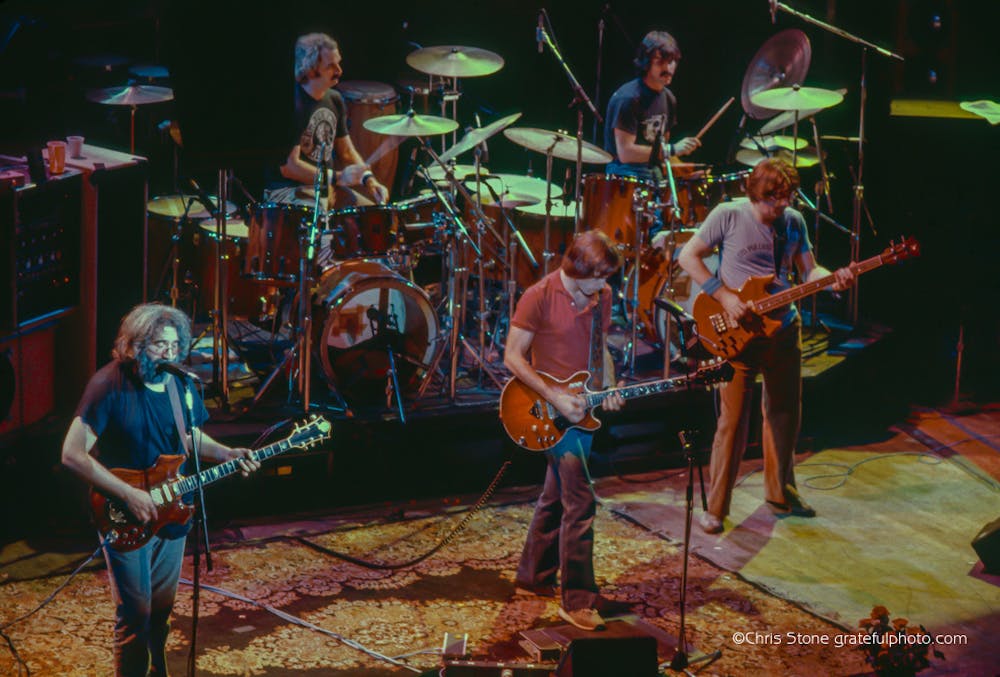Around Bellingham, it’s hard to miss a logo that resembles a skull with a large circular forehead.
For a band that hasn’t played in nearly 30 years, Grateful Dead seems to still have a big following today, especially in Bellingham and along the West Coast.
Sleepy Alligators, a Grateful Dead tribute band from Bellingham, played at Boundary Bay Brewery on Feb. 18. Terrapin Flyer, another Grateful Dead tribute band, played at the Shakedown on May 3.
A tribute band is a band that covers one well-known artist’s music, sometimes mimicking the look and aesthetic of the artist as well.
The Wild Buffalo hosts two to four Grateful Dead tribute bands a year, according to co-owner Craig Jewell.
While there are many Grateful Dead tribute bands, their influence extends past imitations.
On April 4, the Wild Buffalo hosted the band BoomBox, which plays a blend of rock and electronica, founded by Zion Godchaux, the son of two former Grateful Dead members. BoomBox expands on Grateful Dead’s style and even takes a similar approach in that they don’t have a set list and choose songs based on the crowd's energy.
The Grateful Dead’s main draw was their live performances, of which they played over 2,300, according to The SetList Program. They were most famous for their extended improvisations and have been reported as never playing the same song the same way twice.
The band is often called the grandfathers of jam bands, according to New Music World, as they brought improvisational psychedelic music to the masses. Originating in jazz, musical improvisation has found its way into all different types of music, including rap, rock and soul.
By the late ‘60s, the band had such a following that people would pause their lives to follow the band on tour, watching as many shows as possible. The term deadhead was used to describe the group of people who would follow the band all around the county.
Tom Langen is a deadhead who grew up around Seattle and now lives in Bellingham. He said the Grateful Dead is more culturally prominent now than ever. As someone around the Deadhead scene in the early ‘90s, Langen said it wasn't seen as popular or cool.
“You're experiencing art, an artist at work, and you're with a crowd of people, and you're going to get a unique performance whether you like it or not. It's something that can't be experienced through Spotify,” Langen said. “I think the more detached we get as a society or attached through our technology and detached from one another, having those communal experiences like live music performance has actually become more enriching in a lot of ways.”
Timothy Fitzpatrick, the department chair of music at Western Washington University, is knowledgeable about the band that brought jam bands to life. The Grateful Dead’s art form was live performances. Back when they were playing, their audience was primarily younger people looking for a cultural and emotional release, which led them to extreme popularity, Fitzpatrick said.
The Grateful Dead formed in the San Francisco Bay area in 1965. Jerry Garcia, lead guitar and vocals; Bob Weir, rhythm guitar and vocals; Ron "Pigpen" McKernan, keyboards, harmonica and vocals; Phil Lesh, bass and vocals; and Bill Kreutzmann on drums were the founding members of the legendary band. Besides McKernan, who died in 1973, the band’s core members stayed together for the next 30 years.
Dead and Company is a band consisting of former Grateful Dead members Weir, Kreutzmann and Mickey Hart along with John Mayer, Oteil Burbridge and Jeff Chimenti. While they have been playing since 2015, their summer 2023 tour will be their last.
Noah Green is a student at Western and a bassist and singer. He draws inspiration from the Grateful Dead for his music and sees them as a prominent part of Bellingham culture.
“For me, jamming is the most honest form of musical creation because you are following the flow you feel within the song as you play it,” Green said. “I believe that people in Bellingham love to live, and that is something the Grateful Dead felt as well. That is a reason there is such a big following and desire to create music in the way they did.”
Ben Delaney (he/him) is a city life reporter for The Front. He is a junior majoring in environmental studies journalism. In his free time, he enjoys skiing at Mt Baker, fishing on local rivers, and just spending time outdoors. You can reach him at delaney.thefront@gmail.com.






